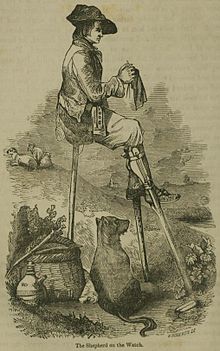Day 3 = March 14, 2014
As I stated yesterday, this week I will be copying from Wikipedia. I searched "History of Knitting" and below are the second 2 sections exactly as listed on Wikipedia.
1855 sketch of a shepherd knitting, while watching his flock.
1855 sketch of a shepherd knitting, while watching his flock.
Importance in Scottish history[edit]
Knitting was such an important occupation among those living on the Scottish Isles during the 17th and 18th centuries that whole families were involved in making sweaters, accessories, socks, stockings, etc.[14] Fair Isle techniques were used to create elaborate colorful patterns. Sweaters were essential garments for the fishermen of these islands because the natural oils within the wool provided some element of protection against the harsh weather encountered while out fishing.
Many elaborate designs were developed, such as the cable stitch used on Aran sweaters, which was developed in the early 20th century in Ireland.Industrial Revolution[edit]
Rudimentary knitting devices had been invented prior to this period, but were one-off creations. With the advent of the Industrial Revolution, wool spinning and cloth manufacture increasingly shifted to factories. Women were employed to operate the machinery, rather than spinning and knitting items at home. The consistency of factory spun wool was better in that it was more uniform, and its weight could be gauged better as a consequence.The city of Nottingham, particularly the district known as Lace Market, dominated the production of machine-knitted lace during the Industrial Revolution and the following decades.
Leicestershire and neighbouring counties, had long had an association with the hosiery industry. This continued particularly growing with the invention of portable circular knitting machines. Machines could be hired and worked from home rather than relying on large stocking frames or the much slower hand knitting. One manufacturer of these machines was Griswold and such work was often called Griswold work.
The mid nineteenth century saw the beginnings of knitting as a hobby. Printed patterns began to be produced, aimed primarily at middle class women. Yarns began to be produced specifically for the domestic market. Rather than knitting being a cottage industry, or commercial necessity it could be a pleasurable and useful pastime.
Question of the day
The knitting history of what country
would you most like to learn about?
would you most like to learn about?
Scottish Knitting,
Victoria
Notes[edit]
14. Jump up ^ Feitelson, Ann. The Art of Fair Isle Knitting. History, Technique, Color & Patterns. Interweave Press LLC, 1996, pp. 19 & 28, ISBN 978-1-59668-138-5.

Scottish!
ReplyDelete